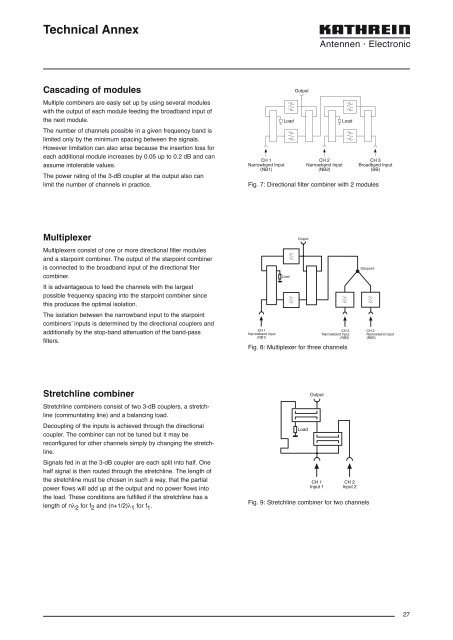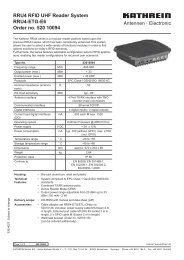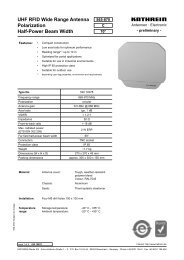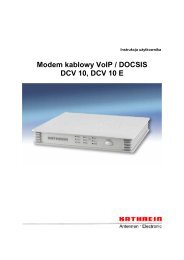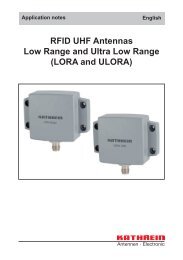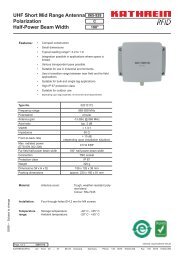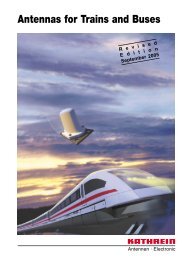Druckschrift 99810560, Combiners and Filters for FM ... - Kathrein
Druckschrift 99810560, Combiners and Filters for FM ... - Kathrein
Druckschrift 99810560, Combiners and Filters for FM ... - Kathrein
You also want an ePaper? Increase the reach of your titles
YUMPU automatically turns print PDFs into web optimized ePapers that Google loves.
Technical Annex<br />
Cascading of modules<br />
Multiple combiners are easly set up by using several modules<br />
with the output of each module feeding the broadb<strong>and</strong> input of<br />
the next module.<br />
The number of channels possible in a given frequency b<strong>and</strong> is<br />
limited only by the minimum spacing between the signals.<br />
However limitation can also arise because the insertion loss <strong>for</strong><br />
each additional module increases by 0.05 up to 0.2 dB <strong>and</strong> can<br />
assume intolerable values.<br />
The power rating of the 3-dB coupler at the output also can<br />
limit the number of channels in practice.<br />
CH 1<br />
Narrowb<strong>and</strong> Input<br />
(NB1)<br />
Load<br />
Output<br />
CH 2<br />
Narrowb<strong>and</strong> Input<br />
(NB2)<br />
Load<br />
CH 3<br />
Broadb<strong>and</strong> Input<br />
(BB)<br />
Fig. 7: Directional filter combiner with 2 modules<br />
Multiplexer<br />
Multiplexers consist of one or more directional filter modules<br />
<strong>and</strong> a starpoint combiner. The output of the starpoint combiner<br />
is connected to the broadb<strong>and</strong> input of the directional fiter<br />
combiner.<br />
It is advantageous to feed the channels with the largest<br />
possible frequency spacing into the starpoint combiner since<br />
this produces the optimal isolation.<br />
The isolation between the narrowb<strong>and</strong> input to the starpoint<br />
combiners’ inputs is determined by the directional couplers <strong>and</strong><br />
additionally by the stop-b<strong>and</strong> attenuation of the b<strong>and</strong>-pass<br />
filters.<br />
CH 1<br />
Narrowb<strong>and</strong> input<br />
(NB1)<br />
Load<br />
Output<br />
CH 2<br />
Narrowb<strong>and</strong> input<br />
(NB2)<br />
Fig. 8: Multiplexer <strong>for</strong> three channels<br />
Starpoint<br />
CH 3<br />
Narrowb<strong>and</strong> input<br />
(NB3)<br />
Stretchline combiner<br />
Stretchline combiners consist of two 3-dB couplers, a stretchline<br />
(communtating line) <strong>and</strong> a balancing load.<br />
Decoupling of the inputs is achieved through the directional<br />
coupler. The combiner can not be tuned but it may be<br />
reconfigured <strong>for</strong> other channels simply by changing the stretchline.<br />
Signals fed in at the 3-dB coupler are each split into half. One<br />
half signal is then routed through the stretchline. The length of<br />
the stretchline must be chosen in such a way, that the partial<br />
power flows will add up at the output <strong>and</strong> no power flows into<br />
the load. These conditions are fulfilled if the stretchline has a<br />
length of nλ 2 <strong>for</strong> f 2 <strong>and</strong> (n+1/2)λ 1 <strong>for</strong> f 1 .<br />
Load<br />
Output<br />
CH 1<br />
Input 1<br />
CH 2<br />
Input 2<br />
Fig. 9: Stretchline combiner <strong>for</strong> two channels<br />
27


